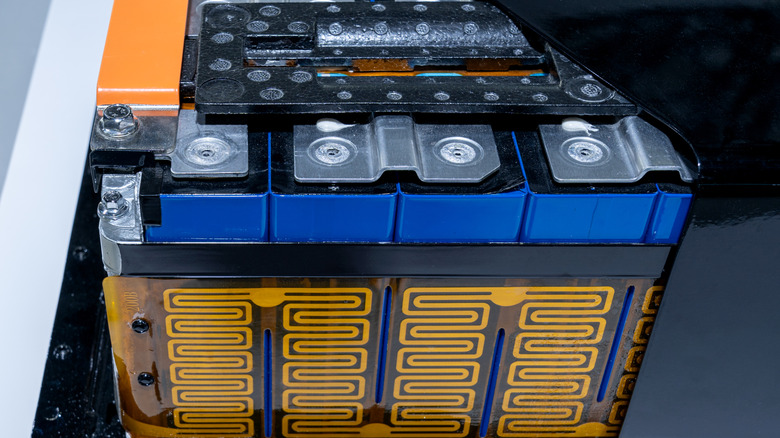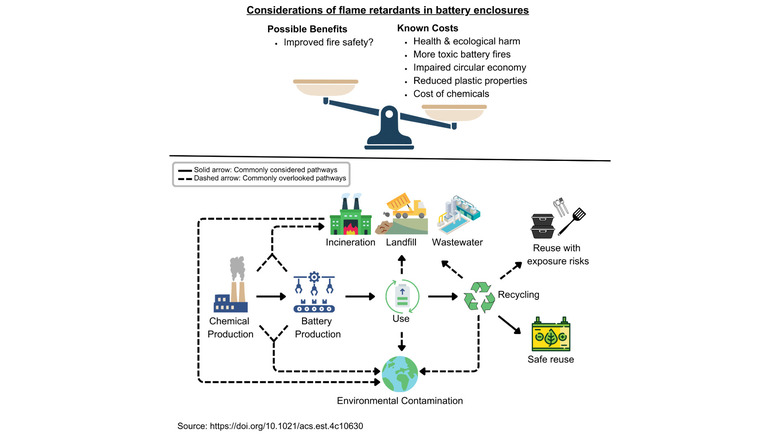Why Fire Retardant Car & Tech Batteries May Be Doing More Harm Than Good
Lithium has become a hotly coveted mineral, and not just due to its integral role in batteries powering gadgets of all sizes. Lithium is very much the future of mobility, thanks to the massive battery packs at the heart of electric cars. Tesla chief Elon Musk even equated it with being "the new oil." However, it seems some industry standard practices that aim to solve the problem of battery fire hazards are creating health risks that could threaten multiple generations.
In a report published in the Environmental Science & Technology journal, experts detailed how flame-retardant plastic battery enclosures are causing more harm than they are doing good. According to scientists at the Green Science Policy Institute, the chemicals added to flame-retardant enclosures are associated with serious health risks such as cancer and can cause harm to the neurological, reproductive, and immune systems of the body. What is even more concerning is the fact that these chemicals pose more harm to young children and pregnant women.
The most perplexing part is that there is little evidence to back the efficacy of these chemicals in the first place. The experts argue that there is no industrially validated research or widely accepted test-based analysis that can provide evidence to support the claim that doping flame-retardant chemicals into battery enclosures effectively mitigates fire risks in everyday scenarios. "Flame retardants in plastics likely cannot slow or stop the highly energetic fires from a lithium-ion battery in thermal runaway," says the California-based non-profit.
What are these fire-retardant chemicals?
According to the United States Environmental Protection Agency (EPA), which is the leading agency for EV regulation, organohalogen fire retardants are extremely persistent and accumulate within biological systems, which poses a two-fold risk. Some of them have been banned or severely restricted in developed countries for decades, yet their presence and ill effects continue to appear.
"These organohalogens are still found in almost all components of the global ecosystem and pose a threat to life on earth," says the agency. The EPA also highlights their carcinogenic risks, in addition to the damage they can do to the nervous, endocrine, and behavioral facilities of humans.
Another research published in the Handbook of Milk Composition says organohalogens bind to the blood cells and their expulsion from the body is slow, leading to slow accumulation. "Compounds were detected in the milk of women with excessive exposures," it further adds.
Yet, aside from the severe health risks they pose, there is another detrimental side that hurts the EV industry, too. These fire-retardant chemicals further pile on to the burden of responsible recycling. Thanks in no part to the world's worsening electronic water problem, the load of these organohalogens is only increasing in the plastic waste stream. "In addition, brominated and chlorinated fire retardants form highly toxic dioxins and furans during the controlled and uncontrolled combustion that is still the unfortunate end-of-life fate for much of the world's electronics enclosures," notes a chapter penned by Dr. Vyto Babrauskas in the 2014 edition of Polymer Green Flame Retardants.
A futile effort against an overwhelming force
Babrauskas, a leading expert in the fire safety sciences, told the Green Science Policy Institute that depending on fire retardants in plastic to prevent thermal runaway fires is like installing a screen door on a submarine. So, why are these toxic fire-retardant chemicals added to the plastic enclosure of batteries that come in all shapes and sizes? To satisfy industrial flammability standards. But it's not just the immediate exposure that is the cause of concern here. According to the research paper penned by the non-profit's in-house scientists, the organohalogen and organophosphate chemicals contaminate the soil, air, and water reservoirs if the plastic waste is not handled carefully.
Existing water filtration and treatment processes, especially those managed at community levels on behalf of the government, are incapable of removing these anti-flame chemicals from entering the human body. Even when such plastics are recycled, they only trickle down in the form of other items, without reducing the chemical risk factor.
As a result, they not only contaminate the food suppliers, but also the entire ecosystem, putting whole communities at risk. Moreover, adding these chemicals only worsens the quality of plastics, further increasing the cost for manufacturers, and the burden of massive recalls that follow. But even their supposed "fire-retardant" chemical behavior can lead to adverse effects. By lowering the combustion temperatures, they allow incomplete burning, which in turn generates more smoke, lethal carbon monoxide, carcinogenic hydrocarbons, and a host of other poisonous gases.
So, what's the solution?
The sum total of the arguments, which is backed by extensive scientific research, is that these fire-retardant chemicals — which find a similar application in other car parts, as well — should be phased out for good. So, how do we move ahead? Take steps to prevent battery fire incidents in the first place, says Arlene Blum, a co-author on the research paper. "Strategies like improving battery management systems and stopping the use of faulty batteries can prevent dangerous thermal runaway fires," she adds.
Experts at the Green Science Policy Institute also argue that policymakers and agencies entrusted with setting up industry standards should focus on allowing chemicals with a proven history of fire-retardant activity. And when they eventually come across such evidence, the focus should be on green-lighting the least harmful fire-retardant chemicals that go into the plastics used for making battery enclosures.
There are already a few replacement candidates, such as metal hydroxides and polymeric flame retardants, but scientists are urging that they should be thoroughly evaluated for all kinds of risks — both short- and long-term. Is there any other promising solution to lithium batteries catching fire? Experts at the University of Arizona are using AI techniques to detect overheating batteries, with hopes of finding a large-scale adoption for integrating their framework. Folks over at the University of Maryland are trying a novel "interlayer" system to reduce the chances of batteries catching fire. Scientists at Stanford propose that reducing the current collector's weight can keep batteries from bursting into flames.



